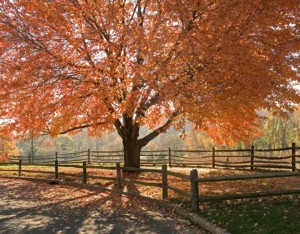
Winter is the time to think about shade trees. This isn’t because we need the shade in the winter months but because it’s the time when many deciduous trees — that is, trees that lose their leaves in winter — become available for sale.
Deciduous trees are grown to a good size in the ground, dug out during winter and transported around the country. The gardener benefits from being able to purchase an advanced tree at a reasonable price. Also, deciduous trees that are transplanted in winter will have the best chances of surviving the move. The main difficulty comes in deciding which tree to grow.
Here are some favourites:
•Floribunda crabapple (Malus floribunda) is possibly the best crabapple variety for warmer areas. It flowers in early to mid spring, with deep-pink buds opening to pale-pink petals. This gives a lovely, multi-coloured effect that is a spring delight. The tree is the perfect size for a small garden.
•Crabapple ioensis (Malus ioensis ‘Plena’) flowers later, with exquisite double blooms that look a bit like small rosebuds. Unfortunately, in warmer areas these are sometimes spoilt by spring heat waves.
•Japanese maples (Acer palmatum) grow into small-headed trees that are ideal for gardens where space is at a premium. They are highly prized for their vivid autumnal foliage in shades of red, orange or yellow.
•Ornamental pears (Pyrus calleryana) have glossy leaves that turn brilliant shades in the autumn. They also feature clouds of white spring blossom. Newer cultivars such as Bradford have upright growth so they make great statement trees.
•Golden ash (Fraxinus excelsior ‘Aurea’) is a larger, drought-hardy shade tree. Its leaves deepen to a rich, golden colour in autumn. It is slow-growing but produces a lovely umbrella-shaped canopy.
Some trees come with their roots wrapped in plastic packaging. Others may have been potted. Because this will have been done quite recently, the mix can be very loose and may fall away from the roots when the plant is removed.
Dig a hole that’s about twice the required width and mix in some compost and organic, natural fertiliser or plant food (like Dynamic Lifter). Add some water-storing granules, because they’ll supply extra moisture during dry periods.
Remove loose material and spread the roots out in the planting hole. Backfill with improved soil and then water well to consolidate the soil around the roots. Apply some soil wetter — either the dry or the liquid variety — over the planting area. This will encourage maximum water entry into the root region. In early spring, spread a layer of organic mulch over the root area so it stays cool and moist through the warmer months.
Pest and disease problems are usually minimal but most deciduous trees will benefit from a copper or lime sulphur spray after the leaves have fallen. (You could try Yates Fungus Fighter, a copper hydroxide formulation that dissolves readily, making it much easier to get complete coverage.)
Check trees for borers in winter. These pests are often easier to spot when trees are bare of leaves. Clear away borer holes and squirt in some pyrethrum spray.
As for winter pruning, once deciduous trees have lost their leaves they can be pruned. Don’t prune, however, unless it will provide some benefit for the tree or for yourself. But don’t prune spring bloomers or you’ll prevent them from flowering. These should be pruned straight after flowering.
Natural selection
• Does the tree have a dense canopy and enough clearance beneath for people to walk or stand?
• Will it produce spiky branches or branches that will drop? What about falling fruit or seed pods?
• Is it fast or slow-growing? If it will take a while to grow, you may need to use an alternative form of shade in the interim.
• Will the shade tree cast shade where you need it?
• Is the root system invasive? Will it disturb the foundations of your house or destabilise paving?
• If it is to be placed close to the house, do you have gutterguards?
• Do you want to use your deciduous trees to help heat and cool the house naturally? If so, the trees should be sited to the east, northeast, north and northwest of the house.
• Do you want a tree that produces pretty blooms like the flowering cherry plum (Prunus x blireana), vivid autumn foliage like the Chinese tallow tree (Sapium sebiferum) or interesting bark like the silver birch (Betula pendula)?






